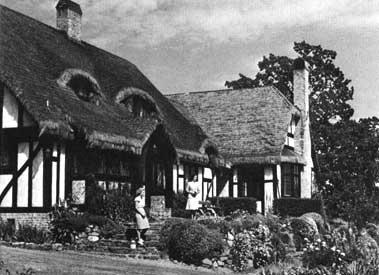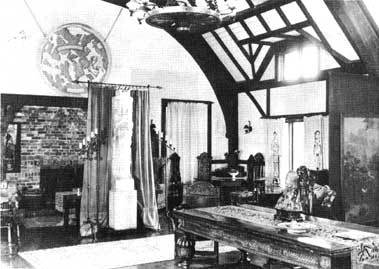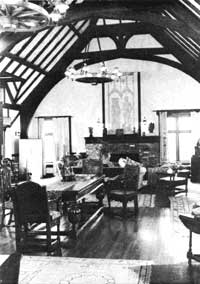John & Katharine Maltwood Collection
| View the Collection |
History of the Collection |
John & Katharine Maltwood |
Information Resources |
Museum at "The Thatch" | ||||||
|
In 1935 the couple grew restless in their Somerset home and moved to "Tocknells House", Painswick, Gloucestershire. However, by 1938 they were so dissatisfied with the state of affairs in Britain they decided to settle in Canada. John Maltwood disliked the financial pressure of Britain's taxation policy and sensed the coming of a second war. For his wife the reasons for moving were more fundamental. Katharine Maltwood felt her art and the evidence she had amassed on the Glastonbury Zodiac would be lost and unappreciated if left in Britain. By bringing it to British Columbia it had a chance to be properly preserved for future generations. Just as the ancient priests had moved west to find a safe home for their sacred knowledge so she hoped to bring the wisdom embodied in the Grail to a new "earthly paradise in the Western seas". That this was her intention is further suggested by the way she brought with her a scion from the famous Holy Thorn of Glastonbury to plant in their new garden. The original hawthorn is renowned for flowering every year on Christmas Day and supposedly grew where Joseph of Arimethea thrust his staff into the ground on Weary All Hill. The scion survived and is now a flourishing tree situated in ground adjacent to the Maltwood Museum's new location on the campus of the University of Victoria. Due to her visionary nature Katharine Maltwood had always cherished a romantic conception of Canada. She saw it as wild, natural, unspoiled and on the upward way of spiritual evolution in comparison to the moral and spiritual decline she associated with Britain. This was the message of Canada awakening to her Destiny, the monument she had carved some twenty-five years earlier and it explains why the sculptress Brynhild Ingmar was portrayed as a young Canadian. Upon their arrival in Victoria the Maltwoods established themselves in a house on Beach Drive in Oak Bay. Shortly afterwards the artist began work on her museum project, a plan to donate the Maltwood Collection to the city along with funds to build a Civic gallery. In a letter to the Municipal Council in April 1939 she explained: "My proposal is that the City of Victoria will devote their site on Douglas to a Fine Art Gallery, I will build the first little hall to house the Maltwood Collection, sketch herewith as the collection would not be available for a few years I propose that the sculpture hail should be used for fine art activities meantime, superintended by Mrs. Uhthoff of the Government Art School." Katharine Maltwood emphasized that such a gallery would be highly desirable both educationally and as a cultural asset to the city. However, although ardently supported by several local artists, including Ina Uhthoff, the museum project was discourteously ignored. It was not until a local restaurant went on sale that she found a solution to the problem. This was the Royal Oak Inn, a picturesque Tudor revival house, on West Saanich Road which the Maltwoods purchased in 1944. They renamed it "The Thatch" and with alterations turned it into a spacious country home aptly suited to displaying their art treasures.
"The Thatch had been built in 1937 and opened as a restaurant. Since an old blacksmith's forge still operated nearby, the original owners had felt it would be appropriate to recreate an old English tearoom. They sought an evocative English design and, after studying Tudor architecture and consulting with local architect Hubert Savage, chose to base the design on a Tudor hall house. Everything in the building was of first rate quality, especially the woodwork with oak floors and hand adzed beams. Fireplaces were inspired by those in existing sixteenth and seventeenth century country homes and a musicians gallery was set in the mezzanine above the great hall.72 It was this medieval English ambiance that appealed to the Maltwoods. In its emphasis on exposed timber and evidence of handcraftmanship the Arts and Crafts principle of natural expression of material and structure can be seen. The Tudor style exemplified the craft ideal of vernacular and sturdy, honest building traditions. English vernacular architecture was admired for its organic qualities; it seemed to be part of the familiar nature amid which it stood.
The Maltwoods' old English furniture and Oriental rugs were well suited to the majestic great hall with its massive timbered roof. Above the large open fireplace to the north was hung a carving in wood of the mystic Glastonbury Zodiac. Below, framed by candelabras and gold curtains, was placed her most important sculptural work, The Holy Grail. Opposite, over the south fireplace, the medieval atmosphere was enhanced by a brass rubbing representing Lord Camoys, K.G., and his wife Elizabeth. This gallant-looking noble had been made Knight of the Garter by King Henry V for commanding the left wing at the battle of Agincourt in 1415. Rubbings of brasses covering other Gothic tombs in English churches were reproduced on white velvet curtains. The fabric of the suite showed a flat floral and leaf pattern repeated in the rhythmic, sinuous lines of Art Nouveau. The great hall also displayed many of Katharine Maltwood's other sculptures complemented by Oriental hangings, pottery and votive objets d'arts.
A copper replica of Magna Mater was hung on the balustrade of the minstrels gallery. Boy Tickling Trout was placed on the terrace outside, its base forming an ornamental bird bath. At the top of the driveway, opposite the blacksmith's shop, a copper electrotype of The Path of Enlightenment stood among the shrubs and trees to greet visitors. The grounds were beautifully landscaped with an emphasis on intimacy, human scale and closeness to nature. In all, the Maltwoods' new home with its informal garden, thatched roof and leaded casement windows, achieved a natural harmony with its environment.
All content on this page is copyright © 7 February, 2006 |
||||||



